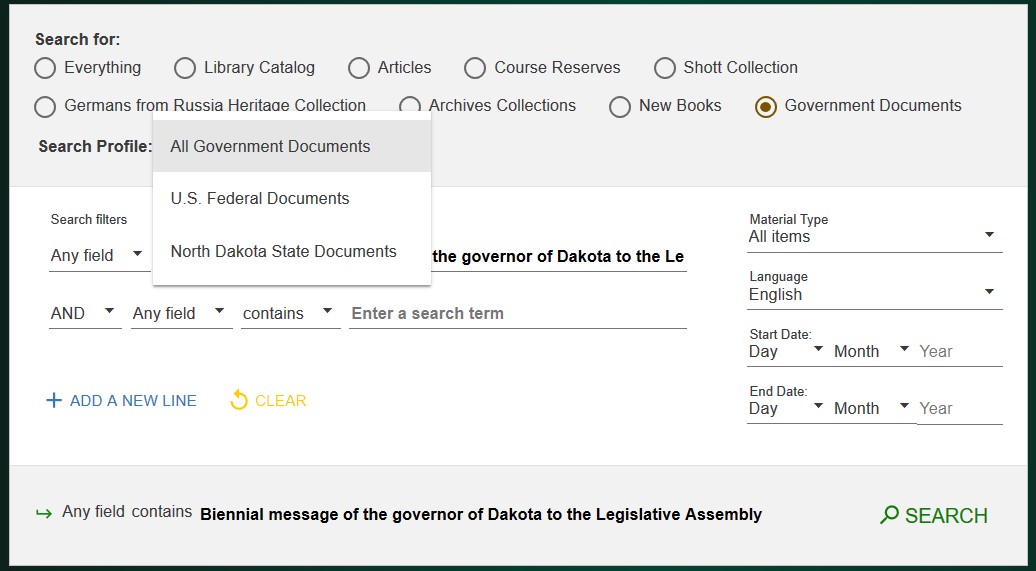Getting started
See the subjects below for information on accessing government information in the library and online. The sites listed are starting points and are only a sample of the information available. .
For a list of State websites and databases go to North Dakota State Information by Subject, for Federal websites and databases go to Federal Government Websites
- Using Google
-
If you need the most current information the agency website may be your best option. You can search a government site by using these terms for better results:
Site:.gov Searches all .gov sites
If you know the agency website, you can include part of the url. Example" site:.cdc.gov
Site:.nd.gov Searches North Dakota sites
- Using the library catalog
-
Use the Advanced Search option and select Government Documents. When you select Government Documents you will have the option to narrow down your search by select all, federal or state documents.

- Finding materials in the library- how they are organized
-
The federal collection is organized beginning with a capital letter or letters representing a government department or agency. (A - Agriculture Dept., C - Commerce Dept., ED - Education Dept., etc.)
The numbers that follow these letters represent the office of a particular department. For instance, all Bureau of Indian Affairs publications will be given a number beginning with I 20. The numbers after the decimal point represent second and subsequent level offices.
In general, documents are shelved in alphabetical and numerical order.
C 3.24/8: IN 23
C 3.25: AF 48
NAS 1.2: FR 76
NS 5: 100
This is not a decimal system. Numbers between punctuation are treated as individual whole numbers.
D 1.2: EX 83
D 1.16: TO 75
D 1.23: NA 42
D 1.23/2: CR 76
Numbers precede letters.
C 61.12: 89-7
C 61.12: AM 32 - The main federal agencies
-
These are some of larger portions of our collection
A: Agriculture/ USDA. This will include the Forest Service, soil surveys, extension service and the Census of Agriculture.
D: The Department of Defense. This section includes the Army, Air Force and Navy. There are also large series of military histories, technical manuals, and reports. Materials from before the establishment of the Department of Defense in 1945 will be under W (War Department) and N (Navy).
E: The Department of Energy.
ED: Education Department
EP: Environmental protection Agency
HE: Health and Human Services Department
HH: Housing and Urban Development Department
HS: Homeland Security, includes ICE, FEMA.
I: Interior Department, includes the Bureau of Indian Affairs, Bureau of Land Management, and the US Geological Survey
VA: Veterans Affairs Department
GovInfo
GPO’s GovInfo provides free online access to official publications from all three branches of the Federal Government.
Data.gov
US government resource for data, tools, and resources for research, application development, data visualizations design, etc.
PubMed
Citations for biomedical literature from MEDLINE, life science journals, and online books. May link to selected full-text content from PubMed Central and publisher web sites.
Census of Agriculture
The Census of Agriculture is a complete count of U.S. farms and ranches and the people who operate them. Even small plots of land if $1,000 or more of such products were raised and sold, or normally would have been sold, during the Census year. The Census of Agriculture, taken only once every five years, looks at land use and ownership, operator characteristics, production practices, income and expenditures.
Bureau of Labor Statistics (BLS)
"The Bureau of Labor Statistics measures labor market activity, working conditions, price changes, and productivity in the U.S. economy to support public and private decision making."
Federal Reserve Economic Data (FRED)
FRED is an online database consisting of hundreds of thousands of economic data time series from scores of national, international, public, and private sources.
FRASER
FRASER is a digital library of U.S. economic, financial, and banking history—particularly the history of the Federal Reserve System.
